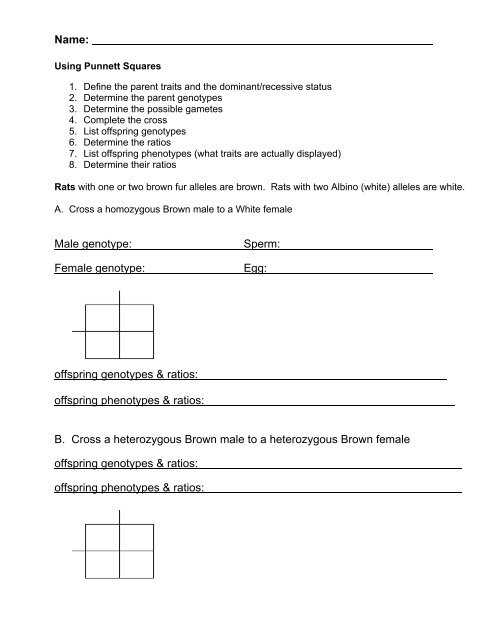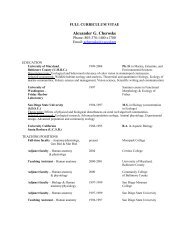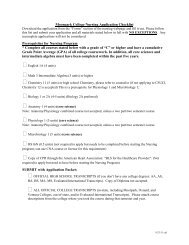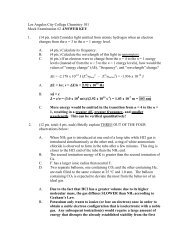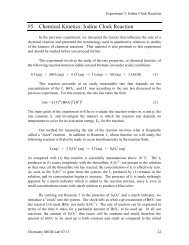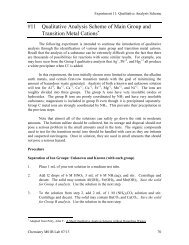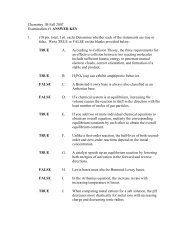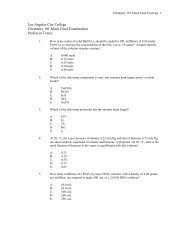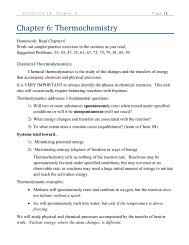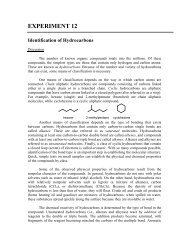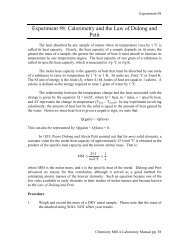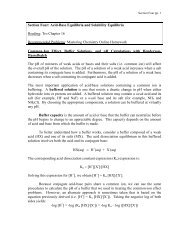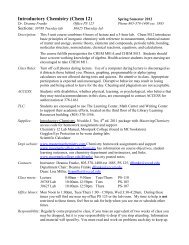Punnett Square Worksheet - Moorpark College
Punnett Square Worksheet - Moorpark College
Punnett Square Worksheet - Moorpark College
- No tags were found...
Create successful ePaper yourself
Turn your PDF publications into a flip-book with our unique Google optimized e-Paper software.
Name:Using <strong>Punnett</strong> <strong>Square</strong>s1. Define the parent traits and the dominant/recessive status2. Determine the parent genotypes3. Determine the possible gametes4. Complete the cross5. List offspring genotypes6. Determine the ratios7. List offspring phenotypes (what traits are actually displayed)8. Determine their ratiosRats with one or two brown fur alleles are brown. Rats with two Albino (white) alleles are white.A. Cross a homozygous Brown male to a White femaleMale genotype:Female genotype:Sperm:Egg:offspring genotypes & ratios:offspring phenotypes & ratios:B. Cross a heterozygous Brown male to a heterozygous Brown femaleoffspring genotypes & ratios:offspring phenotypes & ratios:
Dihybrid Crosses: If we are crossing individuals for two separate traits, and the traits arelocated on two different chromosomes, then the <strong>Punnett</strong> square can be expanded or theprobability on one square can be multiplied times the probability on the other square.( ¼ x ½ = 1/8 ). Follow the same steps listed above.Animal Body character Dominant Recessive Dog Tail Stumpy Long Dog Coat Length Short Long Dog Ear Length Long Short Dog Leg Length Short Legs Long Legs To determine the gametes in a dihybrid cross, use the FOIL method you learned in middleschool math.C. Complete a dihybrid cross between a stumpy tailed, short-legged male that isheterozygous for both traits and a long tailed (homozygous recessive), long leggedfemale. Define the phenotypes & genotypes of the parents, the possible gametes,complete the Punnets square and list the genotype and phenotype ratios of offspring.There are four possible gametes from each parent. Dihybrid crosses require a square with16 inner boxes.)
In horses, coat color is polygenic (many genes on different chromosomes). Black horses can behomozygous or heterozygous because the black gene is dominant. Red horses are homozygous recessive.Coat color is also influenced by a separate gene called "dilution" or "creme." Dilution (creme) horses area paler color, as if their main color (red or black) has been mixed with white. Dilution turns a black intoa grullo (mouse gray color) and a chestnut (red) into a palomino (blond). Heterozygous dilution animalsare one shade lighter than the color of the non-dilute animal. Palominos and grullos are heterozygous.Homozygous dilute animals are called "double-dilutes" and are two shades lighter and also have lightcolored eyes. Homozygous dilution horses are called "cremello" when red or "smokies" when black.When the dilution allele is not present, the horse's coat has full black or red color.D. Complete the <strong>Punnett</strong> square, following all steps, to determine the genotype andphenotype ratios of a cross between a grullo stallion that is heterozygous for black (black& dilute) and a palomino mare (red & dilute.)


